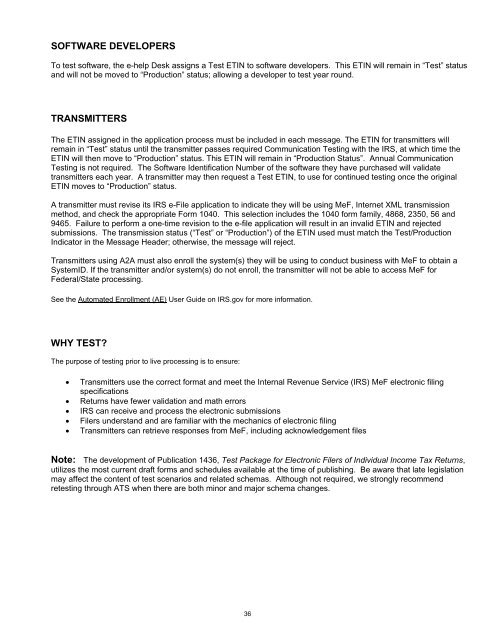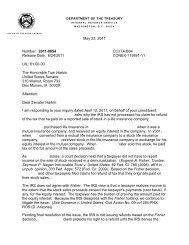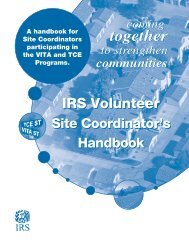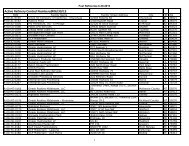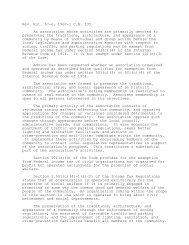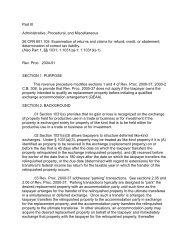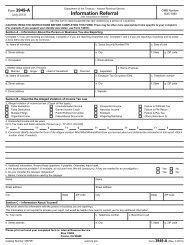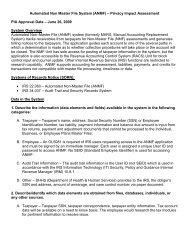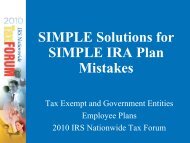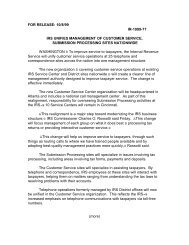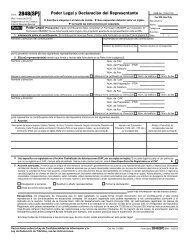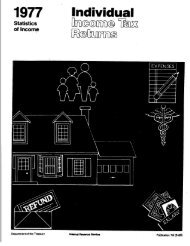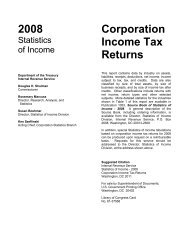Publication 1436 (Rev. 10-2012) - Internal Revenue Service
Publication 1436 (Rev. 10-2012) - Internal Revenue Service
Publication 1436 (Rev. 10-2012) - Internal Revenue Service
You also want an ePaper? Increase the reach of your titles
YUMPU automatically turns print PDFs into web optimized ePapers that Google loves.
SOFTWARE DEVELOPERS<br />
To test software, the e-help Desk assigns a Test ETIN to software developers. This ETIN will remain in “Test” status<br />
and will not be moved to “Production” status; allowing a developer to test year round.<br />
TRANSMITTERS<br />
The ETIN assigned in the application process must be included in each message. The ETIN for transmitters will<br />
remain in “Test” status until the transmitter passes required Communication Testing with the IRS, at which time the<br />
ETIN will then move to “Production” status. This ETIN will remain in “Production Status”. Annual Communication<br />
Testing is not required. The Software Identification Number of the software they have purchased will validate<br />
transmitters each year. A transmitter may then request a Test ETIN, to use for continued testing once the original<br />
ETIN moves to “Production” status.<br />
A transmitter must revise its IRS e-File application to indicate they will be using MeF, Internet XML transmission<br />
method, and check the appropriate Form <strong>10</strong>40. This selection includes the <strong>10</strong>40 form family, 4868, 2350, 56 and<br />
9465. Failure to perform a one-time revision to the e-file application will result in an invalid ETIN and rejected<br />
submissions. The transmission status (“Test” or “Production”) of the ETIN used must match the Test/Production<br />
Indicator in the Message Header; otherwise, the message will reject.<br />
Transmitters using A2A must also enroll the system(s) they will be using to conduct business with MeF to obtain a<br />
SystemID. If the transmitter and/or system(s) do not enroll, the transmitter will not be able to access MeF for<br />
Federal/State processing.<br />
See the Automated Enrollment (AE) User Guide on IRS.gov for more information.<br />
WHY TEST?<br />
The purpose of testing prior to live processing is to ensure:<br />
• Transmitters use the correct format and meet the <strong>Internal</strong> <strong>Rev</strong>enue <strong>Service</strong> (IRS) MeF electronic filing<br />
specifications<br />
• Returns have fewer validation and math errors<br />
• IRS can receive and process the electronic submissions<br />
• Filers understand and are familiar with the mechanics of electronic filing<br />
• Transmitters can retrieve responses from MeF, including acknowledgement files<br />
Note: The development of <strong>Publication</strong> <strong>1436</strong>, Test Package for Electronic Filers of Individual Income Tax Returns,<br />
utilizes the most current draft forms and schedules available at the time of publishing. Be aware that late legislation<br />
may affect the content of test scenarios and related schemas. Although not required, we strongly recommend<br />
retesting through ATS when there are both minor and major schema changes.<br />
36


